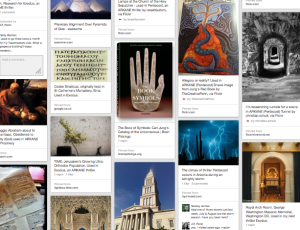Nobody needs yet another social network, but Pinterest is actually really fun! I use it to create boards for my fiction under J.F.Penn ? here?s my ARKANE series research and inspiration.
 I just have a ?Pin It? link on my browser toolbar so it?s very easy to add images I find to the boards without being logged in. But I am certainly not a power user, so in today?s post, Melissa Donovan explains how to use Pinterest more effectively.
I just have a ?Pin It? link on my browser toolbar so it?s very easy to add images I find to the boards without being logged in. But I am certainly not a power user, so in today?s post, Melissa Donovan explains how to use Pinterest more effectively.
When Pinterest hit the Internet, everyone was buzzing about it. I decided to check it out and discovered a social media site for collecting, organizing, and sharing images.
My blog is about writing, which isn?t exactly a visual topic. I didn?t see how I could use Pinterest as a marketing tool and the last thing I needed was another online distraction. It didn?t seem like a place where writers would hang out, so I decided not to sign up.
Imagine my surprise a few months later when I discovered Pinterest was sending a significant amount of traffic to my site. I wasn?t even using it, and some weeks, it was the top social media site referring traffic to my blog. Obviously, Pinterest is a place where writers hang out.
I set up an account and started experimenting. As a result, in 2012, Pinterest ranked fifth in sending referrals my way with relatively little effort on my part.
Tips for Using Pinterest as a Marketing Tool
My experiment with Pinterest continues, but I?ve rounded up some tips and best practices that have proven helpful in using Pinterest to promote my blog and my book. Here are some strategies I?ve developed over the past year:
- Brand your profile: Use your logo, or if you?re an author, use your headshot. Include a short but clear bio letting people know who you are and what to expect from your pins.
- Know your audience: Set up themed boards that reflect your readers? shared interests. For example, if you write fantasy novels, your readers might like images of castles and dragons.
- Keep it clear: Use descriptive rather than cryptic or creative labels for your boards so pinners can find you when they conduct searches.
- Set up board covers: Pinterest is a visual presentation, and your boards look a lot better when you choose vivid and compelling images for their covers.
- Stay focused: If you write cookbooks, you can pin anything food-related from vegetable gardens to table settings. But if you want to pin fashion and celebrities for your personal interests, set up a separate, personal account.
- Speaking of accounts, get a business account. This is a new offering from Pinterest; business accounts include analytics that show how many people pinned from your website, repinned your pins, and other useful data that will help you decide how to best use Pinterest to achieve your goals.
- Be pinnable: Make it as easy as possible for people to pin your stuff. Include images on every page and blog post throughout your website and include Pinterest in your social media share buttons (at the bottom of every blog post). Make sure your websote logo (or header image) is pin-able (many aren?t). I can?t tell you how many times I?ve wanted to pin an article but couldn?t because there wasn?t an image to pin!
- Choose images wisely: It doesn?t hurt to study the rules of good image composition, and then fill your boards with enticing images that inspire other Pinterest users to repin. Pay attention to typography too.
- Check links and captions: This is something I?m still working on. It?s easy to quickly repin a bunch of attractive images but the best practice is to click through to check the link and make sure you want to promote that content. It?s also worth it to take a few seconds to check (and possibly rewrite) the caption.
- Repin: As with Twitter?s retweets, repining on Pinterest is how you get new followers and find new boards to follow. It?s also how you pay it forward and it?s what makes the site social. Do not limit your boards to your own content!
Pinterest for Marketing and Inspiration
 As it turns out, Pinterest can be a lot more than a marketing tool for writers and bloggers. I often discover quotes on writing, articles about writing, and writing tips, and ideas that I can share with my readers. In fact, Pinterest is abundant with inspiration and creative opportunities.
As it turns out, Pinterest can be a lot more than a marketing tool for writers and bloggers. I often discover quotes on writing, articles about writing, and writing tips, and ideas that I can share with my readers. In fact, Pinterest is abundant with inspiration and creative opportunities.
Several authors I follow have set up storyboards as well as boards for characters, plot, and setting. Pinterest is an excellent tool for creating vision boards and it?s a useful tool for collecting, storing, and organizing ideas.
Pinterest is a free, simple, and fun service that writers can use for marketing and as a creative tool. If you haven?t tried it yet, I highly recommend it.
Do you use Pinterest? Please share your boards and how you use the tool in the comments below.
 About the Author: Melissa Donovan is the founder and editor of Writing Forward, a blog packed with creative writing tips and ideas. She has also authored a book of creative writing exercises and works as a web designer and copywriter. You can find her on Pinterest at http://pinterest.com/writingforward/.
About the Author: Melissa Donovan is the founder and editor of Writing Forward, a blog packed with creative writing tips and ideas. She has also authored a book of creative writing exercises and works as a web designer and copywriter. You can find her on Pinterest at http://pinterest.com/writingforward/.
Source: http://www.thecreativepenn.com/2013/04/12/pinterest/
house of representatives paul ryan michele bachmann donald trump Election 2012 map Election Results Map Early voting results
No comments:
Post a Comment